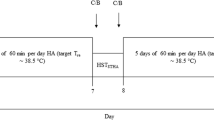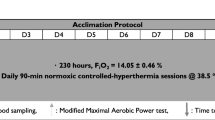Summary
It has been reported that scores from a temperate-environment step test describe the heat-tolerance status of prior heatstroke patients (HP). This investigation evaluated the ability of this temperate-environment heat-tolerance test (HTT) to indicate altered heart rate (HR) and rectal temperature (T re )responses of HP, after 7 days of heat acclimation. On day 1, ten male HP (61 ± 7 days post-heatstroke) and five control subjects (C) bench-stepped (0.30 m high, 27 steps · min−1) for 15 min (25.8° C dry bulb, 16.2° C wet bulb). On days 2–8, subjects underwent heat acclimation (40.1° C dry bulb, 23.8°C wet bulb; treadmill, 90 min · day−1). Heat acclimation resulted in significant decreases in final HR (152±5 vs 130±3 beats·min−1 P<0.025) and finalT re (38.62±0.11 vs 38.13±0.07°C,p < 0.01) in HP. One HP but no C was defined heat intolerant, exhibiting inability to adapt to daily exercise in the heat. On day 9, HP repeated HTT, exactly as performed on day 1; mean group HTT scores did not change (day 1=39±6; day 9=48±6,P>0.05). All physical characteristics and physiological responses of HP (days 1, 2, 7, 9) were statistically similar (P>0.05) to those of C. In contrast to heat-acclimation data, HTT scores (score ≤30) indicated that four HP were heat intolerant on day 1 and two HP were heat intolerant on day 9. It was concluded that HTT was not a substitute for lengthier tests of heat tolerance conducted in hot environments, because HTT scores (at 25.8°C did not reflect HR andT re responses (at 40.1° C) in 33% of heat-acclimated (e.g., heat-tolerant) HP. In addition, HTT scores did not validly discriminate between heat tolerant and heat-intolerant HP.
Similar content being viewed by others
References
Armstrong LE, Pandolf KB (1988) Physical training, cardiorespiratory physical fitness, and exercise-heat tolerance. In: Pandolf KB, Sawka MN, Gonzalez RR (eds) Human performance physiology and environmental medicine at terrestrial extremes. Benchmark Press, Indianapolis, pp 199–226
Armstrong LE, Costill DL, Fink WJ, Bassett D, Hargreaves M, Nishibata I, King DS (1985) Effects of dietary sodium on body and muscle potassium content during heat acclimation. Eur J Appl Physiol 54:391–397
Armstrong LE, Hubbard RW, De Luca JP, Christensen EL, Kraemer WJ (1987) Evaluation of a temperate environment test to predict heat tolerance. Eur J Appl Physiol 56:384–389
Armstrong LE, De Luca JP, Hubbard RW (1989) Time course of recovery and heat acclimation ability of prior exertional heatstroke patients. Med Sci Sports Exerc 22:36–48
Bligh J, Johnson KG (1973) Glossary of terms for thermal physiology. J Appl Physiol 35:941–961
Burch GE (1956) Influence of hot and humid environment on the patient with coronary heart disease. J Chronic Dis 4:350–363
Dill DB, Costill DL (1974) Calculation of percentage changes in volumes of blood, plasma, and red cells in dehydration. J Appl Physiol 37:247–248
DuBois D, DuBois EF (1915) The measurement of the surface area of man. Arch Intern Med 15:868–881
Epstein Y, Shapiro Y, Brill S (1983) Role of surface area-to-mass ratio and work efficiency in heat tolerance. J Appl Physiol 54:831–836
Harrison MH, Edwards RJ, Graveney MJ, Cochrane LA, Davies JA (1981) Blood volume and plasma protein responses to heat acclimation in humans. J Appl Physiol 50:597–604
Hubbard RW, Armstrong LE (1988) The heat illnesses: biochemical, ultrastructural, and fluid-electrolyte considerations. In: Pandolf KB, Sawka MN, Gonzalez RR (eds) Human performance physiology and environmental medicine at terrestrial extremes. Benchmark Press, Indianapolis, pp 305–360
Iampietro PF, Goldman RF (1965) Tolerance of men working in hot, humid environments. J Appl Physiol 20:773–776
Jackson AS, Pollock ML (1985) Practical assessment of body composition. Phys Sportsmed 13:76–90
McArdle WB, Katch FI, Pechar GS (1973) Comparison of continuous and discontinuous treadmill and bicycle tests for\(\dot V_{O_2 \max } \) Med Sci Sports Exerc 5:156–160
Robinson S, Terrell ES, Belding HS, Horvath SM (1943) Rapid acclimatization to work in hot climates. Am J Physiol 140:168–176
Robinson S, Wiley SL, Myhre LG, Bondurant S, Mamlin JJ (1976) Temperature regulation of men following heatstroke. Isr J Med Sci 12:786–795
Shapiro Y, Magazanik A, Udassin R, Ben-Baruch G, Shvartz E, Shoenfeld Y (1979) Heat intolerance in former heatstroke patients. Ann Intern Med 90:913–916
Shvartz E, Shapiro Y, Magazanik A, Meroz A, Birnfeld H, Mechtinger A, Shibolet S (1977a) Heat acclimation, physical fitness, and responses to exercise in temperate and hot environments. J Appl Physiol 43:687–683
Shvartz E, Shibolet S, Meroz A, Magazanik A, Shapiro Y (1977b) Prediction of heat tolerance from heart rate and rectal temperature in a temperate environment. J Appl Physiol 43:684–688
Strydom NB (1980) Heat intolerance: its detection and elimination in the mining industry. S Aft J Sci 76:154–156
Wyndham CH (1973) The physiology of exercise under heat stress. Annu Rev Physiol 35:193–200
Wyndham CH, Benade AJA, Williams CG, Strydom NB, Golden A, Heynes AJA (1968) Changes in central circulation and body fluid spaces during acclimatization to heat. J Appl Physiol 25:586–593
Author information
Authors and Affiliations
Rights and permissions
About this article
Cite this article
Armstrong, L.E., Hubbard, R.W., Christensen, E.L. et al. Evaluation of a temperate-environment test of heat tolerance in prior heatstroke patients and controls. Europ. J. Appl. Physiol. 60, 202–208 (1990). https://doi.org/10.1007/BF00839160
Accepted:
Issue Date:
DOI: https://doi.org/10.1007/BF00839160




